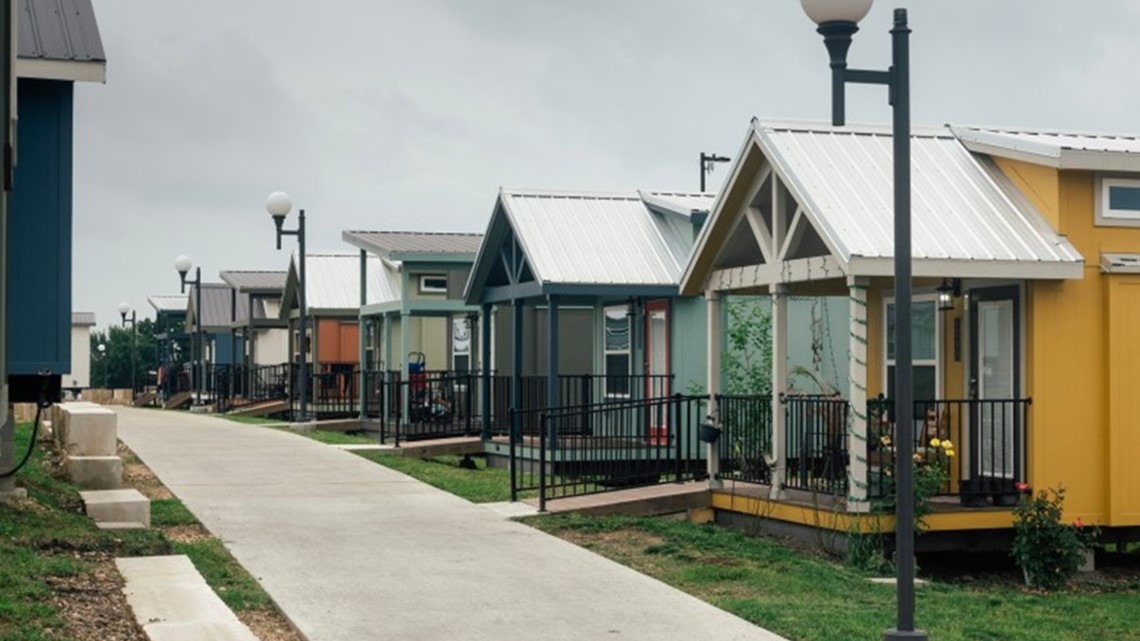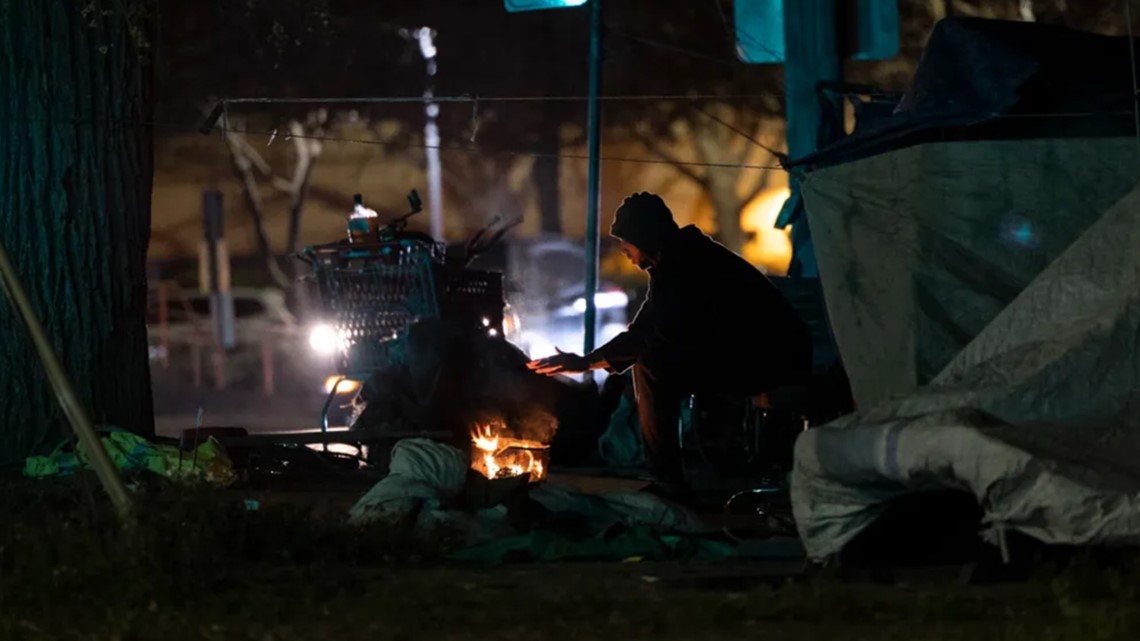CALIFORNIA, USA — This story was originally published by Calmatters.
Sending someone from the street into permanent housing is the ultimate goal for Darden and legions of other outreach workers like him all over America. But it seems to happen more often in Houston, where the homeless population shrank by more than half over the past decade. Compare that to California’s major cities, where the population surged by double-digits, and in some cases triple-digits.
It’s not just Houston. Texas as a whole last year recorded a 28% drop in homelessness since 2012, while California’s homeless population grew by 43% over the same period. In Texas, 81 people are homeless for every 100,000 residents. In California, the rate is more than five times worse.


And that’s despite the fact that Texas spends far fewer state dollars on homelessness. Last year, not counting federal money, Texas put $19.7 million into its three main homelessness programs – equal to about $806 per unhoused person. California, on the other hand, poured $1.85 billion into its three main programs – or $10,786 for every unhoused person.
How do residents view homelessness in each state? The difference is stark: Homelessness is the No. 1 issue on California voters’ minds, according to a recent Quinnipiac University poll. In a 2020 poll of Texas residents, it didn’t even crack the top 10.
Why is Texas doing so much better on homelessness? Right-leaning observers are quick to blame the discrepancy on California’s too-progressive policies. Liberals may distrust the statistics coming out of Texas. But the reality is more nuanced – as California leaders are realizing, while their cities and nonprofits send delegation after delegation to Texas.
With homelessness causing major tension in many California cities, and local and state efforts to get people off the streets continuing to fall short, Golden State leaders are desperate for new solutions. So desperate, that they’re going to a state whose deep-red policies California Democrats are better known for scorning than emulating.
San Jose’s homelessness response team visited Houston earlier this year. City and county representatives from the Los Angeles area went last fall. They came away jealous of some of the advantages Houston has over California cities – such as the lower housing costs that make it easier for the Texas metropolis to find or build homes for people.
But the Californians also were impressed by the way the city coordinates with the county and other local organizations, prioritizes funding for permanent housing instead of temporary shelters and finds places for people before clearing encampments.
“What those folks are doing – really focusing on housing folks – is working,” said Alex Visotzky, senior California policy fellow for the National Alliance to End Homelessness.
In April, two city council members from the East Bay city of Richmond headed to Austin to tour a 51-acre tiny home community that provides permanent housing for 350-and-counting homeless residents. Elected officials from Sacramento trekked to San Antonio to see a 1,600-person shelter that offers everything from dental care to counseling – serving nearly the city’s entire homeless population in one place.




Many experts agree California can learn something from these homeless solutions. But unless the Golden State fixes its housing affordability crisis decades in the making, copying the Lone Star State will get us only so far, said Eric Tars, legal director of the National Homelessness Law Center.
“Elected officials in California are desperate for quick-fix solutions,” he said. “They want a silver bullet to be able to solve homelessness for them. And so when they see results like what’s happening in Houston…they say, ‘that’s great, we want that.’”
California Democrats often at odds with Texas GOP
Texas may seem like an unlikely place for California to find inspiration on anything – especially social services. After all, the Republican-led state is completely out of sync with California’s liberal majorities on everything from guns to abortion to LGBTQ rights – feeding an ongoing public feud between Gov. Gavin Newsom and his Texas counterpart, Gov. Greg Abbott.
Adding to the animosity, the California Legislature and some Golden State cities don’t even allow publicly funded travel to Texas. Some Californians who have made the trip have had to seek exemptions by arguing the travel is in their jurisdiction’s best interest.
“When best practices are happening somewhere, don’t worry about what state they’re in,” said state Sen. Dave Cortese, a Silicon Valley Democrat. “I have no problem looking them right in the eye and saying, ‘I don’t like where you’re going in terms of reproductive rights. I don’t like where you’re going in terms of your stubbornness on mass shootings and gun safety. But I do like what you’re doing on the housing front and I’d like to replicate some of that.’”
Attitudes on homelessness also differ widely between the two states. Earlier this year, 70% of Californians said homelessness is a “big problem” in their part of the state, according to a Public Policy Institute of California poll. That’s up from 63% in 2019. By contrast, just 3% of Texans polled in 2020 said homelessness was the most important issue facing their state, according to the nonprofit Texas Lyceum.
The three Texas cities getting the most attention from California – Houston, Austin and San Antonio – are blue islands in a red state. Houston, a bustling metropolis of 2.3 million people, is Texas’ largest city. Austin, the state’s capital and a mecca for artists, students and foodies, is famously quirky – and urges everyone to “keep Austin weird.” San Antonio lures tourists with the historic Alamo mission and picturesque, restaurant-lined river walk.
Cortese, who recently called for an audit of California’s homelessness spending, tried to bring a version of the Austin tiny home village to Santa Clara County while serving as a county supervisor several years ago, but the idea never got off the ground.
He and others in California argue what the Golden State is doing so far isn’t working, even though Newsom poured nearly $21 billion into housing and homelessness since he took office and vowed the issue is a top priority.
“I don’t want to see any more people die in the streets and call that compassion,” Newsom said last year.


His administration is well aware of the buzz around the Texas programs. Hafsa Kaka, the governor’s new senior adviser on homelessness, said Newsom’s policies compare well against the Texas sites.
Houston, Austin and San Antonio employ the same “housing first” approach that California has used for years, she said.
“While Austin built 350 small homes, we are putting 1,200 across the state, including 500 in Los Angeles,” she said in an emailed statement sent on behalf of Newsom’s office. “California continues to make unprecedented investments into housing and homelessness which includes shelter and wrap-around supportive services, cleaning up encampments, and creating more housing. The state has invested more to increase housing supply than ever before in our history while holding local governments accountable.”
But the difference in outcomes in Texas versus California is unmistakable. The Houston area’s homeless population dropped 57% between 2012 and last year, dipping to 3,124, according to the federally mandated point-in-time count. A New York Times article published last year highlighted the “remarkable progress,” catapulting the city that was already known in wonky homeless policy circles into the national limelight – and catching California’s attention.
Los Angeles County’s homeless population increased 106% over the same period. Sacramento County’s jumped a whopping 230%.
Experts agree the point-in-time counts supplying those numbers — which generally rely on volunteers and outreach workers tallying every homeless person they see over one night — miss portions of the unhoused community. But the counts can be a useful tool to measure the change in a city’s homeless population.
Cheaper rent, more housing
One reason more people find housing in Texas: costs. The median rent for a one-bedroom home in the state was $1,233 in early June, according to Zillow. In California, it was $2,200 – making it harder for people to get and stay housed here.
Land and construction costs are cheaper in Texas, too, and the Lone Star State has fewer regulations that restrict construction. The city of Houston, for example, has no zoning – coupled with a strong mayor who can push projects through – making it easier to build and harder to block housing.
Last year, Texas permitted more than twice as many new homes as California, even though California has about 9 million more residents.
That means even when a California city is doing everything right, it’s still not going to be as successful as its Texas counterpart in reducing homelessness, said Jennifer Loving, CEO of nonprofit Destination: Home in Santa Clara County, who visited Houston in March.
“We do all the same stuff,” she said. “And the major difference is how much housing they have, how quickly it’s getting built.”
But despite its lower housing costs and dramatic drop in homelessness, Houston hasn’t managed to get everyone off the street.

